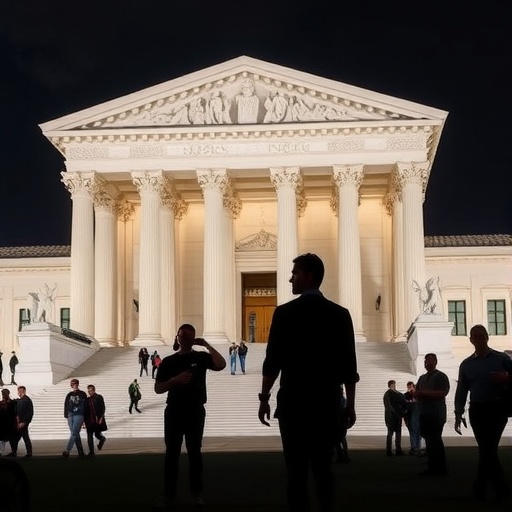Supreme Court Set to Rule on Idaho’s Transgender Athlete Ban: A Pivotal Clash Over Sports Fairness and LGBTQ Rights
In a decision that could reshape the landscape of high school and college sports across the nation, the U.S. Supreme Court has agreed to hear arguments in a high-stakes challenge to Idaho’s controversial ban on transgender athletes competing in sports aligned with their gender identity. The case, stemming from a 2020 law that prohibits transgender girls from participating on female teams, highlights the growing tension between state-level restrictions and federal protections for LGBTQ rights, with more than 25 states now enacting similar measures since Idaho led the charge five years ago.
- Idaho’s 2020 Ban Ignites a Firestorm of State Legislation
- Plaintiffs’ Fight: Personal Stories Fuel the Legal Challenge
- Defenders of the Ban: Arguments Centering on Biological Fairness
- National Ripple Effects: How State Bans Are Reshaping Youth Sports
- Looking Ahead: Potential Outcomes and Lasting Impacts on Sports and Rights
This landmark case arrives at a time when debates over transgender inclusion in athletics have intensified, fueled by concerns about competitive equity, biological advantages, and civil liberties. At its core, the lawsuit argues that Idaho’s ban violates Title IX, the federal law mandating equal opportunities in education, including sports, for all students regardless of gender identity. As the nation’s highest court prepares to delve into this contentious issue, the outcome could set precedents for sports law that ripple through schools, universities, and professional leagues alike.
Idaho’s 2020 Ban Ignites a Firestorm of State Legislation
Idaho made history in March 2020 when Governor Brad Little signed the Fairness in Women’s Sports Act into law, becoming the first state to explicitly ban transgender girls and women from competing on female sports teams at public schools and universities. The legislation, House Bill 500, was championed by Republican lawmakers who argued it was necessary to preserve opportunities for cisgender female athletes, citing potential physical advantages from male puberty in transgender competitors.
Under the Idaho ban, transgender students must compete based on their sex assigned at birth, effectively sidelining those who identify as the opposite gender. This move quickly inspired a wave of copycat laws. According to the Movement Advancement Project, a nonprofit tracking LGBTQ legislation, at least 26 states have now implemented similar restrictions on transgender athletes as of 2024, representing more than half of the U.S. states. These bans vary in scope: some, like those in Texas and Florida, apply to K-12 and collegiate levels, while others, such as in Arkansas, focus primarily on public schools.
The proliferation of these laws has not been without pushback. In Idaho, the ban was immediately challenged by the ACLU on behalf of two transgender high school track athletes, Lindsay Hecox and Jane Doe, who claimed it discriminated against them and violated the Equal Protection Clause of the 14th Amendment. A federal district court issued a preliminary injunction in 2020, halting enforcement, a ruling upheld by the 9th U.S. Circuit Court of Appeals in 2023. Now, with the Supreme Court granting certiorari in late 2024, the case—Hecox v. Little—is poised for oral arguments early next year.
Statistics underscore the human impact: A 2023 survey by the Trevor Project found that 45% of transgender youth considered sports a vital part of their social and emotional well-being, yet bans have led to a reported 30% drop in participation rates among transgender students in affected states. “This isn’t just about sports; it’s about denying kids the chance to be themselves,” said Chase Strangio, co-director of the ACLU’s LGBTQ & HIV Rights Project, in a recent interview.
Plaintiffs’ Fight: Personal Stories Fuel the Legal Challenge
At the heart of the Supreme Court case are real stories of resilience and exclusion. Lindsay Hecox, a 22-year-old transgender woman from Boise, Idaho, has been a vocal plaintiff since the ban’s inception. An avid runner who competed on her high school cross-country team before transitioning, Hecox dreamed of joining Boise State University’s women’s track team. The ban shattered those aspirations, forcing her to the sidelines despite meeting all academic and athletic qualifications.
“I’ve trained my whole life for this, pouring my heart into every mile, only to be told I don’t belong because of who I am,” Hecox shared in a 2023 affidavit filed with the court. Her testimony, echoed by the anonymous Jane Doe—a transgender teen athlete barred from her school’s volleyball team—paints a vivid picture of isolation. Doe described the ban as a “daily reminder that my school sees me as an outsider,” highlighting how such policies exacerbate mental health struggles in the LGBTQ community, where suicide attempt rates among transgender youth are already four times higher than their peers, per CDC data.
The plaintiffs’ legal team argues that the Idaho ban lacks scientific backing for its assumptions about transgender advantages. Citing studies from the Journal of Medical Ethics and the American Medical Association, they note that hormone therapy significantly reduces any purported edges, with many transgender athletes performing comparably to cisgender peers after treatment. “The evidence shows inclusion doesn’t undermine fairness; exclusion does,” Strangio emphasized during a press conference announcing the Supreme Court petition.
Beyond personal narratives, the challenge invokes broader sports law precedents. The plaintiffs reference the Supreme Court’s 2020 Bostock v. Clayton County ruling, which extended Title VII protections against sex discrimination to include gender identity in employment. Extending this logic to Title IX, they contend, would invalidate state bans as discriminatory under federal law. This argument has gained traction in lower courts, with similar injunctions issued against bans in West Virginia and Connecticut.
Defenders of the Ban: Arguments Centering on Biological Fairness
Idaho’s attorneys, backed by a coalition of conservative groups like the Alliance Defending Freedom, counter that the ban is essential for upholding Title IX’s original intent: protecting women’s sports from male physiological advantages. They point to biological differences in muscle mass, bone density, and cardiovascular capacity that persist even after hormone suppression, drawing on research from sports scientists like Dr. Emma Hilton of the University of Brighton.
“We’ve seen records shattered and opportunities lost when biological males compete in women’s categories,” argued Idaho Solicitor General Lance C. Armstrong in appellate briefs. The state cites examples from international swimming, where transgender athlete Lia Thomas’s 2022 NCAA victories sparked outrage among female competitors, though Thomas’s case involved collegiate rather than K-12 sports. In Idaho, proponents reference a 2021 legislative hearing where female athletes testified about feeling “pushed out” in sports like wrestling and track.
Statistics from the Women’s Sports Foundation indicate that girls’ participation in high school sports has grown 10-fold since Title IX’s passage in 1972, crediting it with narrowing the gender gap in athletics. Defenders fear that without bans, this progress could erode, particularly in contact or strength-based sports. “It’s not about excluding anyone; it’s about ensuring a level playing field for the girls who’ve fought for their spots,” said Riley Gaines, a former University of Kentucky swimmer and prominent anti-trans athlete advocate, in a Fox News op-ed last year.
The defense also invokes federalism, arguing that states have the right to set their own policies on education and sports absent clear congressional directive. With the Biden administration’s Department of Education issuing guidance in 2023 supporting transgender inclusion under Title IX, the case pits state sovereignty against federal oversight, a dynamic the Supreme Court has navigated in recent LGBTQ rights decisions like Obergefell v. Hodges (2015) on same-sex marriage.
National Ripple Effects: How State Bans Are Reshaping Youth Sports
The Idaho ban’s journey to the Supreme Court mirrors a broader national schism in sports law. Since 2020, the surge in restrictions has created a patchwork of policies, leaving transgender athletes in limbo. In states without bans, like California and New York, inclusive policies have allowed over 500 transgender students to participate annually, according to a 2024 GLSEN report, fostering environments where LGBTQ rights are prioritized alongside athletic equity.
Conversely, in ban states, enforcement has led to lawsuits and disruptions. Florida’s 2021 Fairness in Women’s Sports Act, for instance, prompted a federal lawsuit by the ACLU, resulting in a temporary block. A 2023 study by the University of Massachusetts found that such bans correlate with a 15% increase in anti-LGBTQ incidents in schools, underscoring their chilling effect on broader rights.
Stakeholders beyond athletes are watching closely. The NCAA, which oversees college sports, has maintained a policy allowing transgender participation with hormone requirements since 2010 but faces pressure to align with state laws. International bodies like the International Olympic Committee updated guidelines in 2021 to emphasize inclusion, yet U.S. states’ actions challenge this global trend. “Sports law is at a crossroads,” noted Professor Deborah Brake of the University of Pittsburgh School of Law in a recent analysis. “The Supreme Court’s ruling could either harmonize or further fragment the field.”
Quotes from affected communities add emotional depth. Andraya Yearwood, a transgender track star from Connecticut who faced similar scrutiny, told The New York Times, “These bans don’t protect anyone—they just hurt kids like me who want to run, to belong.” On the other side, Olympic gold medalist Nancy Hogshead-Makar, founder of Champions for Equality, supports bans, stating, “Title IX was won through blood, sweat, and tears; we can’t let biology be ignored.”
Looking Ahead: Potential Outcomes and Lasting Impacts on Sports and Rights
As the Supreme Court gears up for this pivotal hearing, the stakes extend far beyond Idaho’s borders. A ruling upholding the ban could embolden more states to enact restrictions, potentially solidifying sports law as a battleground for culture wars. Conversely, striking it down would reinforce LGBTQ rights under federal anti-discrimination frameworks, encouraging inclusive policies nationwide and possibly prompting Congress to clarify Title IX’s scope on transgender issues.
Experts predict a narrow decision, perhaps focusing on whether bans constitute sex discrimination. Justice Sonia Sotomayor, in a 2023 dissent on a related case, warned that such laws “perpetuate harmful stereotypes” about gender. With the Court’s conservative majority, outcomes remain unpredictable, but amicus briefs from over 100 organizations—ranging from the NCAA to religious groups—signal intense scrutiny.
Forward-looking, the case could influence emerging debates, like transgender participation in youth leagues or e-sports. Advocacy groups like Human Rights Campaign are mobilizing, with campaigns urging schools to adopt inclusive training. Meanwhile, sports governing bodies may need to revise rules, balancing fairness with access. Ultimately, this Supreme Court showdown on transgender athletes and the Idaho ban could redefine not just who plays, but how America values equality in the arena of sports.
In the words of Hecox, as the nation awaits justice: “This is our shot to run free—without barriers.” The echoes of this fight will resonate in gymnasiums and courtrooms for years to come, shaping the future of sports law and LGBTQ rights in profound ways.










